- Joined
- Sep 28, 2022
@Null By necessity, this is going to be longer than the Talmud but your recent MATI ruminations about whether LFJ spent his time more wisely than you networking with Internet powerbrokers might make this a compelling enough story to forgive the length.
The BLUF is modern technology (e.g. the Internet, the Cloud, and AI) only exists by the grace of God. Our ability to hold the sum total of all human knowledge in the palm of our hand is a blessing and can be ripped from us at any time by an act of God or man’s own folly. Le chadface Nullo, who has spent his time diversifying his skillset into gardening, homesteading, and other traditional areas will have spent his time with this temporary gift more wisely than le virginwalk LFJ, who has placed all his eggs in one basket and has absolutely nothing to fall back on if this gift is taken from us in his lifetime.
The ultimate reason for this is also why you’re probably wrong about AI being able to take down nuclear missiles, which is my particular area of autism.
Part 1: God and the universe LAUGH at our arrogance
Part 2: How a repeat of the Carrington Event will impact the Internet.
Part 3: Why nuclear weapons actually beat AI, on its current trajectory, and Josh’s speculation to the contrary on MATI are wrong.
Part 4: Here’s how AI can still win.
Thank you for listening to my TED talk.
The BLUF is modern technology (e.g. the Internet, the Cloud, and AI) only exists by the grace of God. Our ability to hold the sum total of all human knowledge in the palm of our hand is a blessing and can be ripped from us at any time by an act of God or man’s own folly. Le chadface Nullo, who has spent his time diversifying his skillset into gardening, homesteading, and other traditional areas will have spent his time with this temporary gift more wisely than le virginwalk LFJ, who has placed all his eggs in one basket and has absolutely nothing to fall back on if this gift is taken from us in his lifetime.
The ultimate reason for this is also why you’re probably wrong about AI being able to take down nuclear missiles, which is my particular area of autism.
Part 1: God and the universe LAUGH at our arrogance
To highlight the fragility of the modern Internet, I need to take you back to an event in our history that would destroy it if it happened today: the Carrington Event of 1859.
This was modern history’s greatest recorded solar storm. At the time, the only technology effected was the oldest precursor to the modern Internet; the telegraph. A massive geomagnetic storm caused by solar flares of unprecedented magnitude slamming into the earth’s magnetic field. Aurora borealis were visible from the Rocky Mountains.
A geomagnetic storm is interesting because the charged solar particles interacting with the earth’s magnetic field creates a magnetic flux on the earth’s surface. If you’ve been to a science fair and turned a crank to spin a coil of wires around a magnet (or visa-versa) to light a lightbulb without plugging it in, you’ll know that a magnetic flux generates an electric current in wires.
Back in 1859, the only wires that crisscrossed the earth were telegraph lines. The induced current in these lines gave operators shocks, started fires, and was strong enough in some cases to allow operators to send and receive messages with the power supply disconnected. The strength of this magnetic flux is estimated to be ~1760 nT. This corresponds to roughly 1.4 A/m (keep these numbers in mind because I’ll revisit them later.)
This was modern history’s greatest recorded solar storm. At the time, the only technology effected was the oldest precursor to the modern Internet; the telegraph. A massive geomagnetic storm caused by solar flares of unprecedented magnitude slamming into the earth’s magnetic field. Aurora borealis were visible from the Rocky Mountains.
A geomagnetic storm is interesting because the charged solar particles interacting with the earth’s magnetic field creates a magnetic flux on the earth’s surface. If you’ve been to a science fair and turned a crank to spin a coil of wires around a magnet (or visa-versa) to light a lightbulb without plugging it in, you’ll know that a magnetic flux generates an electric current in wires.
Back in 1859, the only wires that crisscrossed the earth were telegraph lines. The induced current in these lines gave operators shocks, started fires, and was strong enough in some cases to allow operators to send and receive messages with the power supply disconnected. The strength of this magnetic flux is estimated to be ~1760 nT. This corresponds to roughly 1.4 A/m (keep these numbers in mind because I’ll revisit them later.)
Part 2: How a repeat of the Carrington Event will impact the Internet.
The closest modern equivalents to the 18th century telegraph are power and telecommunication infrastructure. Power and telecommunication lines crisscross the earth much more densely than telegraph lines ever did and both are extremely critical elements of the Internet.
So how will a Carrington-like event impact the power grid? I don’t need to speculate on that because we already know what happens when we’re hit by a solar flare a fraction as powerful:
The result of the March 1989 solar storm was widespread blackouts in Quebec. The extra electric current in the powerlines, induced from the magnetic flux caused by the solar storm, caused an electrical surge (or voltage spike) that caused widespread damage and resulted in a blackout. However, power is only one pillar that holds up the Internet.
A technology that was completely absent in 1859 and largely absent in 1989 is the Internet backbone telecommunication grid (e.g. tier 1 ISP infrastructure). I’m not an expert in this technology, so you’ll need to draw your own conclusions based on your own knowledge base but I imagine a voltage spike in the cables that connect data centers together can’t be good for the hard drives connected to it. It’ll probably fry any hardware connected to the Internet.
The final threat to the Internet is the most insidious: Single Event Upsets.
A single event upset is when a bit of memory is corrupted due to a direct hit by an ionizing particle. The exponential rate that computing power is increasing from exponentially tightly packed transistors is both a gift and a curse. The chief drawback is vulnerability to SEUs directly correlates to transistor packing.
Moore’s law dictates that the number of transistors in an integrated circuit double about every two years. So, every two years, the raw vulnerability of our hardware to SEUs also roughly doubles. Luckily, our extremely tightly packed grids of transistors are currently mostly safe from the errant cosmic particle due to the protection of earth’s magnetic field. We haven’t yet seen the effects an extremely energetic solar storm of ionized particles will have on both Internet and AI. For reasons that I’ll get into with my nuclear weapons sperging later, I believe that particles from a sufficiently energetic solar storm will quite literally rip through entire banks of tightly packed transistors, which will corrupt the underlying data of both the Internet and AI if we “hit” the solar lottery.
So how will a Carrington-like event impact the power grid? I don’t need to speculate on that because we already know what happens when we’re hit by a solar flare a fraction as powerful:
The result of the March 1989 solar storm was widespread blackouts in Quebec. The extra electric current in the powerlines, induced from the magnetic flux caused by the solar storm, caused an electrical surge (or voltage spike) that caused widespread damage and resulted in a blackout. However, power is only one pillar that holds up the Internet.
A technology that was completely absent in 1859 and largely absent in 1989 is the Internet backbone telecommunication grid (e.g. tier 1 ISP infrastructure). I’m not an expert in this technology, so you’ll need to draw your own conclusions based on your own knowledge base but I imagine a voltage spike in the cables that connect data centers together can’t be good for the hard drives connected to it. It’ll probably fry any hardware connected to the Internet.
The final threat to the Internet is the most insidious: Single Event Upsets.
A single event upset is when a bit of memory is corrupted due to a direct hit by an ionizing particle. The exponential rate that computing power is increasing from exponentially tightly packed transistors is both a gift and a curse. The chief drawback is vulnerability to SEUs directly correlates to transistor packing.
Moore’s law dictates that the number of transistors in an integrated circuit double about every two years. So, every two years, the raw vulnerability of our hardware to SEUs also roughly doubles. Luckily, our extremely tightly packed grids of transistors are currently mostly safe from the errant cosmic particle due to the protection of earth’s magnetic field. We haven’t yet seen the effects an extremely energetic solar storm of ionized particles will have on both Internet and AI. For reasons that I’ll get into with my nuclear weapons sperging later, I believe that particles from a sufficiently energetic solar storm will quite literally rip through entire banks of tightly packed transistors, which will corrupt the underlying data of both the Internet and AI if we “hit” the solar lottery.
To summarize Josh’s position, he feels that the exponentially increasing computing power of AI will lead to extremely sophisticated guidance systems what will be capable of intercepting Intercontinental Ballistic Missiles or ICBMs. My position is that the way computing power is increasing right now, by tightly packing transistors on circuit boards, the vulnerability of sophisticated guidance systems to Electromagnetic radiation from nuclear detonations is actually increasing. To counter sophisticated guidance systems, nuclear war planners would only need to detonate their ICBMs in a cascade (e.g. the ones in front detonate and the ones behind fly through the resulting EMP what would fry any sophisticated missile guidance system.) In addition, detonating a nuke in space, over whatever complex the AI is housed will likely kill the AI due to the resulting geomagnetic storm.
The most obvious question is “why would ICBM guidance systems be unaffected by an EMP while sophisticated AI-driven missiles be bricked?” The answer requires a Putin-style history lesson. I’m going to begin with some good ol’ fashioned journo bashing.
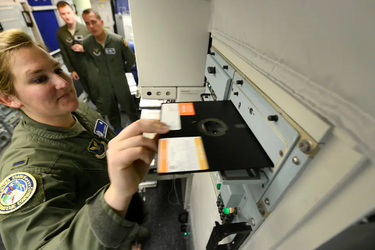
Condescending journalists have been smugly preening about the antiquated 1970s computing technology used in all ICBMs for the entirety of 21st century to date. What they’ve never cared to research is the fact the US government actually pays a handful of tech companies to continue to churn out 1970s-style computers at a premium. The reason is related to Moore’s Law and Single Event Upsets.
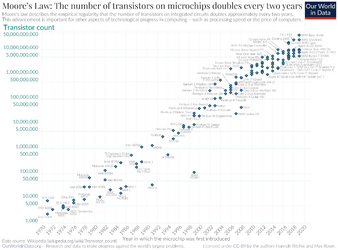
A nuclear weapon spits out an ungodly amount of ionized particles in what is called an electro-magnetic pulse or EMP. During the cold war, we were terrified of an alpha strike from the Soviet Union which would 1) cause a geomagnetic storm, wiping out our power grid and electronics (HEMP) and 2) fry any electronics connected to the grid (SREMP). A considerable amount of thought and Engineering went into developing solutions to these problems. For example, each ICBM silo has a massive electronic surge arrestor vault that will absorb the voltage spike from commercial power lines and diesel generators supply power when commercial power is toast.
EMP in space is HEMP and EMP close to the surface is SREMP. The HEMP only induces current in power and telecommunication lines via geomagnetic storm over a continent-sized area. SREMP causes SEUs and induces a much larger current but it’s over a smaller area and also blasts electronics with energetic ionized particles. Here are two helpful figures to help you keep them straight:
HEMP (causes gemagnetic storms):
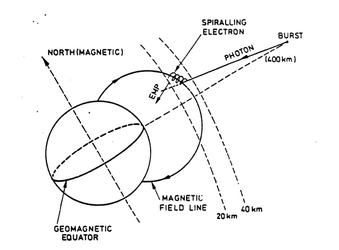
SREMP (fries electronics in the conventional understanding of EMP):
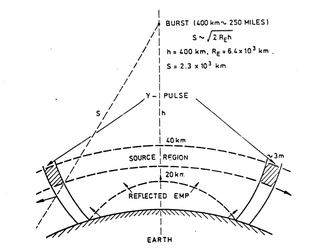
To bring this back full circle to the Carrington Event of 1859, a geomagnetic storm caused by a nuclear weapon is in the 10 – 100 amps/m range, depending the yield. Or the 1257 – 125664 nT range. In other words, a nuke can cause a geomagnetic storm that is between a similar magnitude and one hundred times more powerful than the Carrington Event. This means that we technically have a modern event that was similar to the Carrington Event: The Starfish Prime test of 1962:
Fun fact: the results of this test freaked out the United States government so much that we shared the results of the test with Russia so they wouldn’t be tempted to recreate it. It’s also why the use of nuclear weapons in space is prohibited by international treaty.
The people who designed the electronics for our ICBMs were the same people who put us on the moon and knew how to design extremely hardened electronics. Sure, it was 1970s tech but that tech had been proven to work in space, far outside the protective envelope of earth’s magnetic field. Part of the resistance to radiation is the loosely spaced transistors but the other part is the transistors are intelligently oriented in 3D space and the software has multiple redundancies, so it’ll still work if over half of the transistors are fried by radiation. A figure helps visualize here but none of my sources for this are on the Internet, so a crude pic will need to suffice:
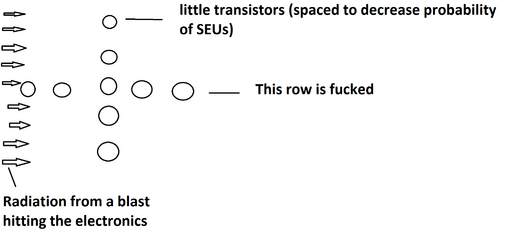
I’m not an expert but I imagine it’s quite difficult to design a software program that’ll accounts for over half of the transistors spontaneously being deleted and works with an amount of RAM and memory that’ll make any modern programmer scoff but the mad lads pulled it off. These men are all dead or retired but their ghosts will still be able to beat AI in the direction it’s going for decades to come through the sheer pandora’s box that is the nuclear weapon.
The most obvious question is “why would ICBM guidance systems be unaffected by an EMP while sophisticated AI-driven missiles be bricked?” The answer requires a Putin-style history lesson. I’m going to begin with some good ol’ fashioned journo bashing.

Condescending journalists have been smugly preening about the antiquated 1970s computing technology used in all ICBMs for the entirety of 21st century to date. What they’ve never cared to research is the fact the US government actually pays a handful of tech companies to continue to churn out 1970s-style computers at a premium. The reason is related to Moore’s Law and Single Event Upsets.

A nuclear weapon spits out an ungodly amount of ionized particles in what is called an electro-magnetic pulse or EMP. During the cold war, we were terrified of an alpha strike from the Soviet Union which would 1) cause a geomagnetic storm, wiping out our power grid and electronics (HEMP) and 2) fry any electronics connected to the grid (SREMP). A considerable amount of thought and Engineering went into developing solutions to these problems. For example, each ICBM silo has a massive electronic surge arrestor vault that will absorb the voltage spike from commercial power lines and diesel generators supply power when commercial power is toast.
EMP in space is HEMP and EMP close to the surface is SREMP. The HEMP only induces current in power and telecommunication lines via geomagnetic storm over a continent-sized area. SREMP causes SEUs and induces a much larger current but it’s over a smaller area and also blasts electronics with energetic ionized particles. Here are two helpful figures to help you keep them straight:
HEMP (causes gemagnetic storms):

SREMP (fries electronics in the conventional understanding of EMP):

To bring this back full circle to the Carrington Event of 1859, a geomagnetic storm caused by a nuclear weapon is in the 10 – 100 amps/m range, depending the yield. Or the 1257 – 125664 nT range. In other words, a nuke can cause a geomagnetic storm that is between a similar magnitude and one hundred times more powerful than the Carrington Event. This means that we technically have a modern event that was similar to the Carrington Event: The Starfish Prime test of 1962:
Fun fact: the results of this test freaked out the United States government so much that we shared the results of the test with Russia so they wouldn’t be tempted to recreate it. It’s also why the use of nuclear weapons in space is prohibited by international treaty.
The people who designed the electronics for our ICBMs were the same people who put us on the moon and knew how to design extremely hardened electronics. Sure, it was 1970s tech but that tech had been proven to work in space, far outside the protective envelope of earth’s magnetic field. Part of the resistance to radiation is the loosely spaced transistors but the other part is the transistors are intelligently oriented in 3D space and the software has multiple redundancies, so it’ll still work if over half of the transistors are fried by radiation. A figure helps visualize here but none of my sources for this are on the Internet, so a crude pic will need to suffice:

I’m not an expert but I imagine it’s quite difficult to design a software program that’ll accounts for over half of the transistors spontaneously being deleted and works with an amount of RAM and memory that’ll make any modern programmer scoff but the mad lads pulled it off. These men are all dead or retired but their ghosts will still be able to beat AI in the direction it’s going for decades to come through the sheer pandora’s box that is the nuclear weapon.
Part 4: Here’s how AI can still win.
The weakness of modern technology isn’t due to the transistor becoming smaller. A small transistor on a large circuit board is actually more resistant to radiation. The issue is the current trend of miniaturization and packing those tiny transistors as close together as possible. That just increases the likelihood of an errant electron knocking out an entire bank of transistors.
AI that can beat nukes may be theoretically possible but it’ll unironically look closer to HAL or the Nostromo’s “Mother” than anything modern science fiction has dreamed up.

You need lots of extremely small transistors intelligently placed in 3D space and extremely efficient code, RAM, and memory that takes less for granted than modern code. It’ll take a cutting-edge Engineering effort. Someone could make it happen but I doubt it’s going to be the current intuitions facing a DEI competency crisis. Maybe China will pull it off.
AI that can beat nukes may be theoretically possible but it’ll unironically look closer to HAL or the Nostromo’s “Mother” than anything modern science fiction has dreamed up.

You need lots of extremely small transistors intelligently placed in 3D space and extremely efficient code, RAM, and memory that takes less for granted than modern code. It’ll take a cutting-edge Engineering effort. Someone could make it happen but I doubt it’s going to be the current intuitions facing a DEI competency crisis. Maybe China will pull it off.
Thank you for listening to my TED talk.